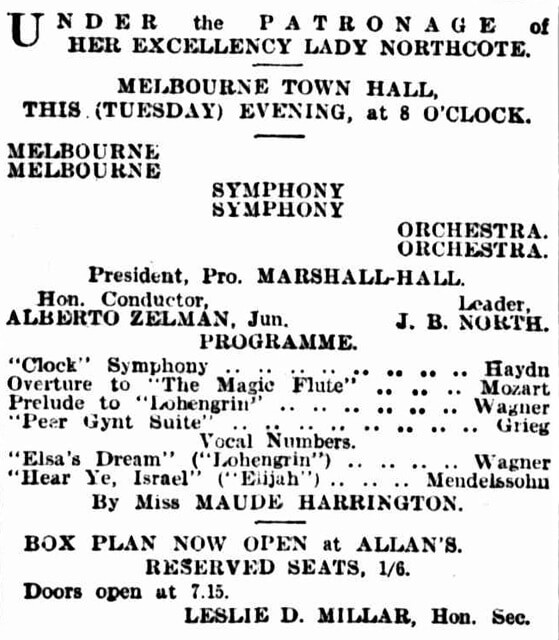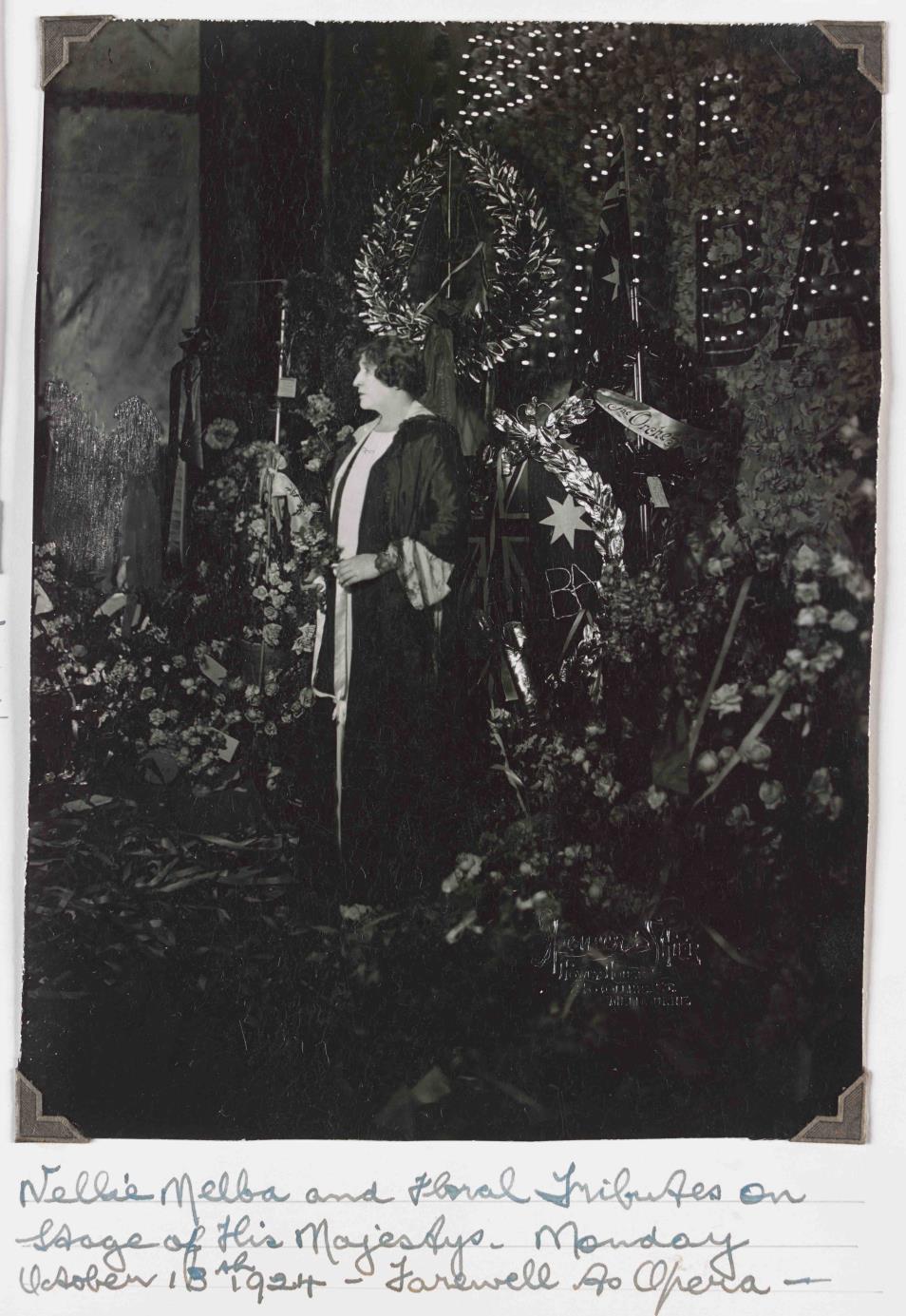From 1901-1927 the new Commonwealth of Australia was governed and administered from Melbourne, while a new national capital city was built in Canberra. These were turbulent years. Dreams of a modern, progressive society were tested by the horrors of the Great War, the 1919 influenza pandemic and systemic unemployment in the 1920s. Melbourne during these years was a divided society.

Federation
1 January 1901
The six separate British self-governing colonies of New South Wales, Victoria, Tasmania, South Australia, Queensland and Western Australia united to form the Commonwealth of Australia.

22 January 1901
The Old Treasury Building in mourning after the death of Queen Victoria on 22 January.
29-30 March 1901
The first elections for the new Federal Parliament were held on 29 and 30 March. Edmund Barton became the first Prime Minister.
9 May 1901
Opening of the first Parliament of Australia at the Royal Exhibition Building in Melbourne.
3 September 1901
Australia’s flag was flown for the first time at the Royal Exhibition Building.
Other important events of 1901
The first act of the Federal Parliament, the Immigration Restriction Act, was passed. Now known as the infamous ‘White Australian Policy’, the new law introduced strict controls over who could migrate to Australia.
Businessman Harley Tarrant built one of the earliest Australian-made, petrol-driven cars in a small workshop in Melbourne.
The first free kindergarten was established in Baptist Hall, Carlton.

February 1902
The Waterside Workers’ Federation of Australia (WWFA) is formed. W.M. (Billy) Hughes (later Prime Minister) was its first president.
12 June 1902
Through the Commonwealth Franchise Act, Australia became the first country in the world to grant women both the right to vote (in federal elections) and the right to stand for parliament. This meant women in Victoria could vote in federal elections, but not state elections. The same act effectively disenfranchised Indigenous Australians.
Other important events of 1902
The first publicly available women’s lavatories in Melbourne were built. It cost a penny to use the toilet.

February 1903
A ‘grand suffrage demonstration’ was held at the Melbourne Town Hall.
Article printed in Mount Alexander Mail, 28 February, 1903.
15 August 1903
William Barak, artist and significant leader in Victoria’s Aboriginal community, died at Coranderrk.
September 1903
Alfred Deakin became the second Prime Minister of Australia.
Other important events of 1903
Vida Goldstein was the first woman in the British Empire to stand (unsuccessfully) for election to a national parliament.
Members of the suffrage movement formed the Women’s Federal Political Association with Vida Goldstein as President. They ran a vigorous campaign for state suffrage in Victoria.

Victoria’s first state secondary school, Melbourne Continuation School, opened in Spring Street.
First motor vehicle fatality.

11 December 1906
First concert of the Melbourne Symphony Orchestra, the oldest professional orchestra in Australia.

10 July 1907
Sydney and Melbourne were first linked by telephone.
Other events of 1907
Justice HB Higgins, President of the Commonwealth Conciliation and Arbitration Court, handed down the ‘Harvester Judgement’, to establish Australia’s basic wage.

10 June 1908
The Invalid and Old-Age Pensions Act passed.
18 November 1908
After 19 separate bills since 1889, the Victorian Adult Suffrage Act finally passed. It gave white Victorian women the same voting rights as men for state elections. Aboriginal women had to wait until 1962. Women had won the right to vote, but not the right to stand as candidates for Victorian parliamentary elections.

1 March 1910
The first powered flight in Australia was made by Ralph Banks at Diggers Rest (approximately 30 kms northwest of Melbourne).
Other events of 1910
Registration of motor vehicles and licensing of drivers was made compulsory.
The first Australian silver coins were introduced. Prior to this British coins were used.
Melbourne’s new Flinders Street Station was completed. Detail of Architectural drawings for the proposed railway station at Flinders Street, by JW Fawcett and HPC Ashworth, c. 1900-1908. Image courtesy Public Record Office Victoria.

16 November 1911
Women voted in Victorian elections for the first time.
Other events of 1911
All boys 14-18 were required to train as cadets and (until 25) become part of a citizen defence force.

10 October 1912
The Maternity Allowance Act passed. White Australian mothers were paid £5 on the birth of a child.

September 1913
Women’s Industrial Convention called for a ‘living wage’ for women as well as men.
Other events of 1913
First official airmail service flight from Melbourne to Sydney by Frenchman M. Guillaux. The flight took two days.
The first Australian postage stamp was issued.

July 1914
The Myer Emporium opened in Bourke Street, Melbourne.
4 August 1914
Great Britain declared war on Germany. Australian Prime Minister Joseph Cook promised 20,000 troops ready to ship out in six weeks, proclaiming it was the nation’s duty to ‘remember that we are Britons’. By the end of 1914, 52,561 men had enlisted in the Australian Imperial Force. More than one hundred Aboriginal Victorians answered the call – despite the Defence Act 1909 which prohibited any person not of ‘substantially European’ origin from serving.
In 1914 Victorians marched innocently into war, Collins Street, Melbourne. Courtesy State Library Victoria

October 1914
Under the War Precautions Act, residents of German or Austro-Hungarian descent could be interned without trial.
Other events of 1914
The Australian Red Cross (then called the Australian Branch of the British Red Cross) was formed. By the end of the war the Red Cross in Melbourne had issued 324,716 pairs of socks, 112,488 pairs of pyjamas, 102,215 handkerchiefs, 39,449 kitbags, 6,230,795 cigarettes, 25,165 bandages, 27,698 pounds of chocolate, 211,284 tins of fruit, amongst other items.
Victoria’s schools were involved in raising money for the war, from knitting to selling rabbit skins. Teachers donated up to 2.5 per cent of their monthly salary. By the end of the war, Victorian schools had raised a staggering £438,000 for the War Relief Fund, donated £35,000 worth of food to Victorian military hospitals and supplied 400,000 articles for distribution by the Australian Comforts Fund. Lennie and Dorothy Bruton of Lilydale knitting to raise money for the War Relief Fund.

25 April 1915
Landing of Allied Forces at Gallipoli. A crowd waiting outside the Argus Office in Melbourne waiting for news from Gallipoli, 1915 Courtesy Australian War Memorial.

July 1915
The Women’s Peace Army was formed by Adela Pankhurst. ‘We war against war’ was their motto.

October 1916
There was a shortage of men volunteering to enlist. A plebiscite for conscription was narrowly defeated. The conscription debate was one of the fiercest and most divisive in Australian political history. The Australian Labor Party split over the issue and Prime Minister Billy Hughes led a break-away faction to form the Nationalist Party, which won election in 1917. First World War anti-conscription propaganda poster Courtesy State Library Victoria.
Other events of 1916
The strong temperance movement won early closing of public bars (6pm). Originally a war time move, it remained in force until 1966.

August 1917
Strikes began against high prices and low wages.
August-September 1917
In August and September, high food prices led to food riots in Melbourne. Organiser, Adela Pankhurst, was arrested and gaoled.
December 1917
Australians voted against conscription for a second time by a greater majority. Australia, South Africa and India were the only countries to rely on volunteers during the First World War.
Other events of 1917
Enlistment regulations were changed to allow Aboriginal men with one white parent to join up. Ultimately, up to 800 Indigenous men served with the AIF during the First World War.
First women police officers appointed (in Melbourne).

September 1918
The first direct radio message was received from Britain.
11 November 1918
The First World War ended. In all, nearly 417,000 Australians enlisted, 112,399 Victorians. 156,000 Australians were wounded, gassed or taken prisoner. More than 60,000 were killed, 16,863 from Victoria.
Other events of 1918
Dr Vera Scantlebury and others founded the Victorian Baby Health Centres Association (VBHCA) to provide free infant health care.

25 January 1919
A world-wide influenza pandemic reached Melbourne. Some 12,500 Australians died. Aboriginal deaths were particularly high. Worldwide the epidemic claimed 21 million people, more than the total number of people killed in the war. Hospital Beds in Great Hall During Influenza Pandemic, Exhibition Building, Melbourne, Feb 1919. Image courtesy Museums Victoria.
19 July 1919
Peace Day celebration march ended in riots with many arrests.
21 July 1919
Disgruntled crowd of ex-servicemen invaded the Treasury Building. High unemployment fuelled resentment. Government offices were ransacked and the Premier was assaulted and hit over the head (reports claim with a heavy inkwell).
Other events of 1919
There were 5,720 factories in Melbourne, employing 122,349 people.
First electric train service.
Royal Commission into the Basic Wage found that the minimum wage fell short by about 30% of the basic cost of living for a family with three children.
6,150 German internees, including naturalized Australian citizens, were deported to Germany.

1921
Population of greater Melbourne was 782,979, 51% of the total Victorian population.

1922
Registrations of motor cars, trucks and cycles doubled between 1917 and 1922, reaching a total of 44,750, but car ownership was still beyond most people.

31 October 1923
Large numbers of Victorian police in the city of Melbourne went on strike, protesting against the system of supervision by plain-clothes constables, known as 'spooks'.
After a week of disorder, the government authorised the formation of a special force to replace the strikers. A civilian force of five thousand special constables, led by Lieutenant-General Sir John Monash, was issued with wooden batons and instructed to restore order.
This was the first and, to date, the only strike by a police force in Australia.
A queue of men lining up outside the Melbourne Town Hall to volunteer as special constables during the Police Strike. Courtesy State Library Victoria
Other events of 1923
65% of registered factory workers in Victoria were women.

26 January 1924
Regular radio broadcasting began on Station 3AR.
May 1924
Women were finally granted the right to stand for election to the Victorian Parliament.
June 1924
The first woman, Alicia Katz, stood as a Labor candidate for the Victorian Parliament, but was defeated.
June 1924
The new state-owned power station at Yallourn was turned on providing cheap, bulk power produced from brown coal.
13 October 1924
The first of Melba’s ‘final’ farewell performances in Australia at His Majesty’s Theatre. Nellie Melba and floral tributes on stage, 13 October 1924 Courtesy State Library Victoria
Other events of 1924
Coranderrk Mission was officially closed as an Aboriginal reserve after a long campaign by Aboriginal and other activists to save it.
Between 1924 and 1940 all cable tram lines were electrified.

April 1925
The Victorian Government declared 25 April a public holiday. Other states followed the example.
Article printed in The Argus, 8 April, 1925.

1926
Commonwealth Scientific and Industrial Research Organisation (CSIRO) founded in Melbourne.

1927
It is estimated the Aboriginal population declined by 27 per cent between 1901 and 1927.
The birth rate in Australia was half that of the 1880s.
The Australian Federal Government and Parliament officially left Melbourne for the purpose built capital of Canberra. Federal Parliament first sat in Canberra on 9 May, but many government departments continued to operate from Melbourne for some years.








